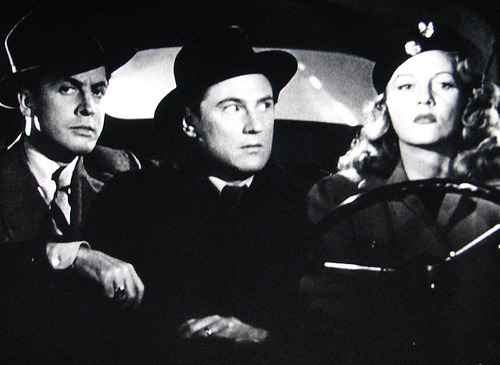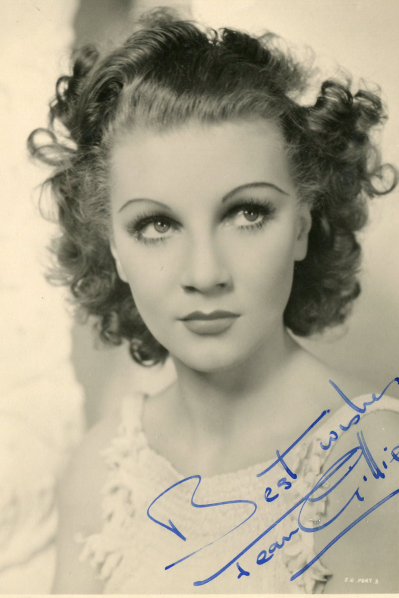Having been out of print for four decades did a lot to raise the status of Decoy in a lot of peoples’ minds. In truth, it’s a second-tier film noir; stylistically, it doesn’t do much for the medium, and it suffers from some lackluster performances and a lot of scenes that seem padded out. (There can’t be more than a few dozen lines of dialogue in the whole movie, but it’s not due to any kind of sparse, efficient, Hemingwayesque storytelling; it just has a bunch of long patches where no one has much to say.) Its plot is sheer hokum, with the jumbo Egg McGuffin being the use of methylene blue to revive someone who’s just been sent to the gas chamber; this useful little feature comes as news to anyone who’s mostly familiar with its ability to turn your piss the color of Windex. Coming at the tail end of World War II, it’s decidedly of the first wave of noir, before it settled into an established style and let itself push back against the restrictions of the studio system; as a result, Decoy often scans as an old-school pre-war crime picture, skirting the edges of melodrama at every turn and afflicted with a truly oppressive score by Edward Kay.
Even the big twist ending is pretty easy to figure out; to be perfectly honest, and with all apologies to the spoiler-averse, it’s right there in the title. Anyone who can’t see it coming probably hasn’t seen many movies. But that doesn’t stop it from being a real gut-punch when it’s finally delivered; like any brutal blow, just because you can see it coming doesn’t mean it’s not going to hurt like hell when it finally arrives. (It also neatly establishes Frank Olins, played by veteran sharpie Robert Armstrong, as one of the meanest sons-of-bitches in motion picture history, even though he’s been dead for half the film.) In a way, this is characteristic of Decoy‘s appeal: it’s predictable, sure, and in many ways second-rate, but its emotional power, when manifested, is hard to deny. That’s what makes it worth watching after all the ‘vanished classic’ hype has died down — that and one of the nastiest noir ladies this side of Detour‘s razor-fanged Vera. I’m not of the dogmatic school of critics who insist that a movie needs a femme fatale to qualify as noir, but when I get one, I expect her to be so close to the top she’s fit to spill over, and Jean Gillie doesn’t disappoint.
It’s her character, Margot Shelby, that drives the action from the beginning. In one of Decoy‘s only truly stylish moments (the other being a tricksy POV execution scene), it opens with Herbert Rudley in a shitty gas-station bathroom, washing his filthy hands and staring at his own reflection in a shard of mirror. Dead-eyed and silent, he hitches a ride to San Francisco and immediately guns Margot down. An unsurprised Det. Joe Portugal (the dickish cop played by an off-puttingly snide Sheldon Leonard in what passes for the movie’s hero) sends for backup, expressing not a bit of surprise that someone might want to put a bullet in her; the story then unfolds in flashback as she makes her confession, bleeding out on a fainting couch. The money-hungry moll of a hood specializing in bank jobs, she visits him on Death Row after he murders a guard during his latest heist. He’s hidden the money, and she arranges a series of double-crosses and unlikely scenarios (including the above-mentioned methylene blue maneuver) to get him out and get him to spill the location of his take. Along the way, she implicates Rudley, who, it is revealed, is the prison doctor, and engineers her own downfall. Along the way, there’s some interesting business, but most of it revolves around character rather than action. Rudley’s assistants (one of whom is bit player Louis Mason, who had a memorable role in The Grapes of Wrath) play out a fun variation of the gravediggers in Hamlet, and Leonard — resplendent in what looks like a used zoot suit, and hassling bartenders while munching on hard-boiled eggs — may be the most loathsome hero cop in noir.
But it’s Jean Gillie (sorry, Miss Jean Gillie) who’s really the draw here. Margot Shelby was a stretch for her; though an experienced actress, she’d only been in British films before, and always in the roles of comic heroines or good girls. Her husband was Decoy‘s director, Jack Bernhard, who’d met her during the war; why he chose to introduce her to an American audience in a role so contrary to her usual type is hard to imagine. The toothy Gillie wasn’t a great actress, but she threw herself into the role of an utterly heartless, murdering backstabber as best she could; all flashing smile and contemptuous laugh, she tried to sell the role with her face when it was clear that it wasn’t going to get sold with her voice (a rather schoolmarmish public-school London accent). There are moments in the script that require her to go so hard that it shakes the screen, particularly in her hateful dealings with Rudley; if she can’t quite make it, it’s not for lack of trying. It’s that effort that sells the movie’s final scene; Leonard is too busy being satisfied with himself to make it work, but Gillie has put so much into it by that point that when it happens, it’s almost like watching someone defile her corpse. Not that she doesn’t have it coming, but the trick of a good femme fatale is that you constantly wish for her to get her comeuppance, and when it finally happens, you’re left feeling a little ashamed of yourself. In another creepy similarity to its Poverty Row cousin, Detour, Gillie herself would be as stalked by tragedy as her character: she and Bernhard soon divorced, and he abandoned all support of her career; she’d make only one more movie, and within two years, she was dead of pneumonia, at age 33.


